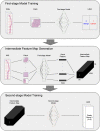Yet Another Automated Gleason Grading System (YAAGGS) by weakly supervised deep learning
- PMID: 34127777
- PMCID: PMC8203612
- DOI: 10.1038/s41746-021-00469-6
Yet Another Automated Gleason Grading System (YAAGGS) by weakly supervised deep learning
Abstract
The Gleason score contributes significantly in predicting prostate cancer outcomes and selecting the appropriate treatment option, which is affected by well-known inter-observer variations. We present a novel deep learning-based automated Gleason grading system that does not require extensive region-level manual annotations by experts and/or complex algorithms for the automatic generation of region-level annotations. A total of 6664 and 936 prostate needle biopsy single-core slides (689 and 99 cases) from two institutions were used for system discovery and validation, respectively. Pathological diagnoses were converted into grade groups and used as the reference standard. The grade group prediction accuracy of the system was 77.5% (95% confidence interval (CI): 72.3-82.7%), the Cohen's kappa score (κ) was 0.650 (95% CI: 0.570-0.730), and the quadratic-weighted kappa score (κquad) was 0.897 (95% CI: 0.815-0.979). When trained on 621 cases from one institution and validated on 167 cases from the other institution, the system's accuracy reached 67.4% (95% CI: 63.2-71.6%), κ 0.553 (95% CI: 0.495-0.610), and the κquad 0.880 (95% CI: 0.822-0.938). In order to evaluate the impact of the proposed method, performance comparison with several baseline methods was also performed. While limited by case volume and a few more factors, the results of this study can contribute to the potential development of an artificial intelligence system to diagnose other cancers without extensive region-level annotations.
Conflict of interest statement
H.C., I.P. and Y.M. are employees of Deep Bio Inc. T.-Y.K. is the chief technology officer of Deep Bio Inc. S.-J.S. declares no conflict of interest.
Figures




Similar articles
-
Automated deep-learning system for Gleason grading of prostate cancer using biopsies: a diagnostic study.Lancet Oncol. 2020 Feb;21(2):233-241. doi: 10.1016/S1470-2045(19)30739-9. Epub 2020 Jan 8. Lancet Oncol. 2020. PMID: 31926805
-
Self-Learning for Weakly Supervised Gleason Grading of Local Patterns.IEEE J Biomed Health Inform. 2021 Aug;25(8):3094-3104. doi: 10.1109/JBHI.2021.3061457. Epub 2021 Aug 5. IEEE J Biomed Health Inform. 2021. PMID: 33621184
-
WeGleNet: A weakly-supervised convolutional neural network for the semantic segmentation of Gleason grades in prostate histology images.Comput Med Imaging Graph. 2021 Mar;88:101846. doi: 10.1016/j.compmedimag.2020.101846. Epub 2021 Jan 13. Comput Med Imaging Graph. 2021. PMID: 33485056
-
The 2014 International Society of Urological Pathology (ISUP) Consensus Conference on Gleason Grading of Prostatic Carcinoma: Definition of Grading Patterns and Proposal for a New Grading System.Am J Surg Pathol. 2016 Feb;40(2):244-52. doi: 10.1097/PAS.0000000000000530. Am J Surg Pathol. 2016. PMID: 26492179 Review.
-
An update of the Gleason grading system.J Urol. 2010 Feb;183(2):433-40. doi: 10.1016/j.juro.2009.10.046. Epub 2009 Dec 14. J Urol. 2010. PMID: 20006878 Review.
Cited by
-
Deep learning based approach: automated gingival inflammation grading model using gingival removal strategy.Sci Rep. 2024 Aug 26;14(1):19780. doi: 10.1038/s41598-024-70311-y. Sci Rep. 2024. PMID: 39187553 Free PMC article.
-
Development and Evaluation of a Novel Deep-Learning-Based Framework for the Classification of Renal Histopathology Images.Bioengineering (Basel). 2022 Aug 30;9(9):423. doi: 10.3390/bioengineering9090423. Bioengineering (Basel). 2022. PMID: 36134972 Free PMC article.
-
A deep learning system for prostate cancer diagnosis and grading in whole slide images of core needle biopsies.Sci Rep. 2022 Mar 1;12(1):3383. doi: 10.1038/s41598-022-07217-0. Sci Rep. 2022. PMID: 35233002 Free PMC article.
-
A systematic review and meta-analysis of artificial intelligence diagnostic accuracy in prostate cancer histology identification and grading.Prostate Cancer Prostatic Dis. 2023 Dec;26(4):681-692. doi: 10.1038/s41391-023-00673-3. Epub 2023 Apr 25. Prostate Cancer Prostatic Dis. 2023. PMID: 37185992
-
Addressing Challenges and Controversies in the Management of Prostate Cancer with Multidisciplinary Teams.Target Oncol. 2022 Nov;17(6):709-725. doi: 10.1007/s11523-022-00925-7. Epub 2022 Nov 18. Target Oncol. 2022. PMID: 36399218 Free PMC article. Review.
References
-
- Prostate Cancer—Cancer Stat Facts. https://seer.cancer.gov/statfacts/html/prost.html. Accessed 6 Apr 2020.
-
- National Comprehensive Cancer Network (NCCN). Practice Guidelines in Oncology: Prostate Cancer Early Detection. Version 2. 2019. https://www.nccn.org/professionals/physician_gls/pdf/prostate_detection.pdf Accessed 12 Mar 2020 (2019).
-
- Gleason DF. Classification of prostatic carcinomas. Cancer Chemother. Rep. 1966;50:125–8. - PubMed
LinkOut - more resources
Full Text Sources

